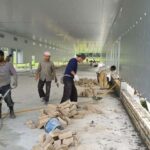SELANGOR, 25 Feb 2019: Armed with shovels, spades and 1,200 saplings of Tenggek burung (Melicope lunu-ankenda) and 10 trees of Ramin melawis (Gonystylus bancanus), the Selangor State Forestry Department (SSDF), Global Environment Centre (GEC) and Friends of North Selangor Peat Swamp Forest (FNSPSF) led 328 volunteers comprising local community, schools and university students as well as the public to re-plant a degraded area of Raja Musa Forest Reserve (RMFR) in Bestari Jaya on Saturday morning. The event aims to promote conservation and wise use of peatland in support from HSBC Malaysia – in conjunction with Selangor State Level Celebration of World Wetlands Day1 2019.
The event also saw the launch of Peatland Forest Ranger Training Module by Abdul Khalim Abu Samah, Deputy Director of Selangor State Forestry Department representing Dato’ Dr. Mohd Puat Dahalan, Selangor State Forestry Department Director. Peatland Forest Ranger is an educational programme initiated by GEC in February 2012 to educate secondary school children on the importance of environmental protection, specifically peat swamp forest ecosystem.
In addition, Junior Peatland Forest Ranger was also established in April 2014 with primary focus towards educating elementary school children. With the publication of Peatland Forest Ranger Module, GEC hopes to inspire the younger generations in protecting our peat swamp forest through interactive learning approach which includes camping-like training, outdoor learning environment, field trips and group activities.
During the launch of the module, Abdul Khalim Abu Samah said, “The idiom ‘strike while the iron is hot’ bears a powerful lesson in our concerted efforts to rehabilitate what has been degraded. Raja Musa Forest Reserve saw 1,000 hectares of degraded land in 2008 due to forest fire which then illegally encroached by people and turned into farms or agricultural and settlement areas. It is the younger generations of today that will have to step up, retain, restore and preserve this particular Selangor peatland.”
Abdul Khalim Abu Samah further commented that in their efforts to rehabilitate the degraded areas of RMFR, SSDF have also managed to establish a good partnership with their stakeholders, the NGOs, and local community as well as corporates like HSBC Malaysia to work together towards revitalising the roles of a peat swamp forest, which are to symbiotically sustain the habitat of flora and fauna as well as maintain carbon cycle and water storage and supply functions.
Stuart Milne, Chief Executive Officer, HSBC Malaysia said of this initiative “HSBC Malaysia has long supported the Selangor State Government and the Selangor State Forestry Department on the rehabilitation programme of the North Selangor peat swamp forest, including the Raja Musa Forest Reserve. Since 2011, we have worked together with the Selangor State Government and the Selangor State Forestry Department towards the success of the peatland management, protection and restoration. We also had over 1300 HSBC colleagues volunteer in this meaningful and impactful programme since 2011; reflecting our commitment towards making a difference in the environment and the lives of people in the communities in which we operate. I do hope that this initiative will further increase community awareness on the importance of wetlands in the tropical rainforest ecosystem and their role in tackling climate change.”
According to the RAMSAR Convention on Wetlands, the unique ecosystem of wetlands is its natural power that can turn the tide on climate change. For example, peatlands which cover only 3% of the Earth, store nearly a third of land-based carbon.
This is twice as much as the biomass of all the world’s forests combined. Coastal wetlands such as salt marshes, mangroves and seagrass beds are also some of the most carbon-dense ecosystems on earth. However, unhealthy and degraded wetlands can turn the tide against climate change, as it contributes to global warming by transforming these natural carbon sinks into emission sources.
Faizal Parish, GEC’s Director who is also an international peatland expert said “Raja Musa Forest Reserve in Selangor has a unique ecosystem. Its hydrological function helps mitigate floods, maintain river base flows, provide habitat for endangered and endemic species of flora and fauna as well as replenish drinking water. Importantly, as 81,304 hectares of peat swamp forest, NSPSF is also able to act as a vital carbon sink reduce carbon in the atmosphere.
This event is in line with the 2019 World Wetlands Day theme which is Wetlands and Climate Change that seeks to demonstrate the vital role of wetlands in coping with the threats of climate change. Also, in conjunction with the International Mother Language Day, celebrated each year on the 21st February which promotes the importance of linguistic diversity, an awareness peat poster that includes four languages (English, Mandarin, Malay, and Tamil) was distributed to facilitate a better understanding of the importance of management and conservation of peatlands in Malaysia, especially in Selangor. We hope that the existing collaboration with SSFD, HSBC Malaysia & FNSPSF will be able to gain more success outcomes in the future. ”
To commemorate GEC’s 20th anniversary since its establishment in 1998, GEC with SSFD is organising regular tree planting events at North Selangor Peat Swamp Forest throughout 2019. This activity is aimed at conserving the peat swamp forest and restoring the deteriorated area to its former glory, to help tackle climate change problems. This initiative also aims to get more public and target groups including children to be more involved and exposed in wetlands conservation and rehabilitation activities to increase awareness.
For more information on rehabilitation programme and how you can get involved, please contact GEC or visit www.gec.org.my or visit the Selangor State Forestry Website.









